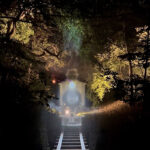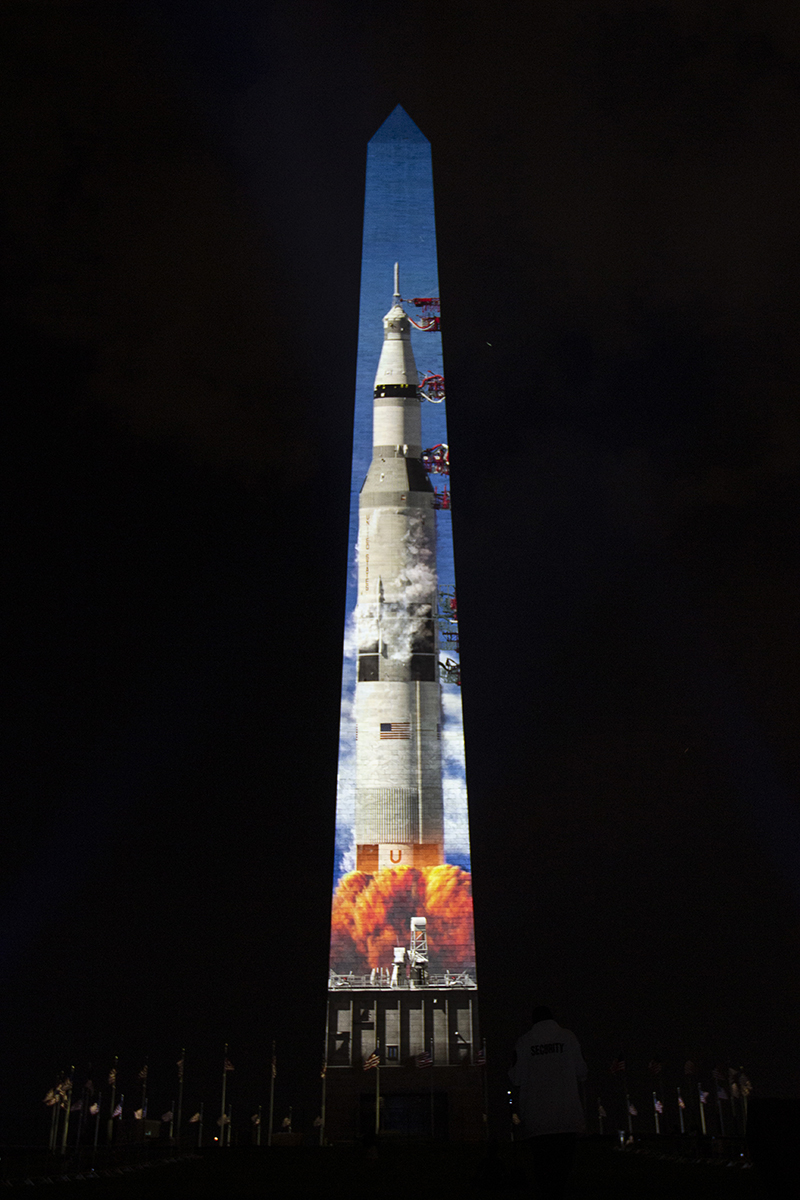
Projection-Mapped Visuals Celebrate 50 Years Since Man First Walked on the Moon
n late July, the Smithsonian’s National Air and Space Museum treated the public to a five-night celebration of 50 years since man first stepped foot on the moon with large-scale projection-mapped images on the Washington Monument.
On July 16, 17 and 18, from 9:30 to 11:30 p.m., the projections depicted a static, full-sized, 363-foot Saturn V rocket on the 555-foot-high monument’s eastern façade as a “teaser” of sorts for the main show on July 19 and 20. That’s when a special 17-minute show, Apollo 50: Go For The Moon, presented projection-mapped video on the monument along with side screens and an audio track to tell the Apollo 11 story, with the help of archival footage and images from JFK’s inspirational speeches the Saturn V rocket’s assembly and liftoff, and the astronaut’s daring voyage into space and moon landing, followed by their safe return to earth.
The presentation was conceived and commissioned by the Smithsonian’s National Air and Space Museum (NASM) and made possible by a unanimous, bipartisan joint resolution of Congress, then implemented through a partnership with the U.S. Department of the Interior and 59 Productions. 59 Productions is a multi-award-winning company of artists, architects, designers and technologists offering expertise in design for stage and live events, architectural projection-mapping to exhibition design, VR experiences and technical consultancy.
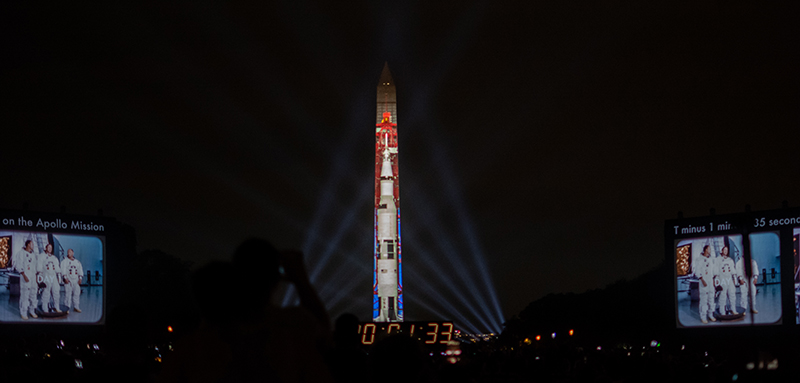
Apollo 50 Mission Control
For the beginning phase of the project, 59 Productions director Richard Slaney worked with Danny Whetstone, founder and president of DWP Live, meeting with NASM executive producers Katie Moyer and Nick Partridge to discuss initial concepts nearly a year ahead of the event.
DWP provided all power and infrastructure for all departments including all projection structures, audio structures, and FOH structures via Whetstone’s direct relationship with United Staging and Aggreko. DWP also addressed all office/tech/production trailers and their infrastructure needs. “It is a similar hierarchy that we have shared with 59 on many projects to date,” says Whetstone.
Created in 2006 and led by directors Leo Warner, Mark Grimmer, Lysander Ashton, Richard Slaney and Anna Jameson, 59 Productions created the video design of the opening ceremony of the London 2012 Olympic Games, the design and creative direction of the record-breaking David Bowie is exhibition and the projection and video design of the National Theatre stage production, War Horse, which has reached audiences of more than 7 million people in 11 countries.
As the fundamental technology provider, DWP’s direct responsibilities included providing system control, projection and a fiber optic /network backbone. Through his close and personal relationships with Eighth Day Sound, Elite Multimedia, Pete’s Big TV’s and Aggreko, Whetstone contracted for sound, supporting video and power. Elite provided the 40-by-eight-foot (WxH) 4.8mm pixel pitch LED wall, which recreated the Kennedy Space Center countdown clock. Pete’s brought in all the mobile LED displays for overflow.
The monument projection setup included the use of 24 Barco UDX-4K32 projectors. They were converged as six zones of projection and blended together for seamless, full coverage of the monument’s east façade.
Jeff Holt, account executive with Silver Spring, MD-based Atmosphere Inc., tells PLSN that Reid Santabarbara, one of the production managers with 59 Productions, was the person responsible for Atmosphere’s involvement with the Apollo 50 celebration project. “He is actually an LD as well, based out of Seattle, and had used us earlier in the year on a different show. Reid brought us in to implement the lighting system for the Apollo project and put me in direct contact with Benjamin Pearcy, lighting designer with 59 Productions,” Holt notes. “Benjamin specified the outline of gear and what he wanted to achieve. The big requirement was everything had to be rated at IP55 or better, due to the event being outdoors. I had to reach long and far to fulfill the list.”
The setup included Elation Proteus Beams for flag lights around the monument, Claypaky Mythos 2 fixtures for the main beams flanking and emanating from the monument, and Chauvet Maverick Storms, which were deployed for the audience two blocks away from the actual projection surface on the monument. “Old-school ColorBlasts were used as ‘house lights,’” Holt adds. Claypaky Mythos 2 fixtures, the only non-water-resistant fixture type specified, were encapsulated in Claypaky Igloo Domes.
“Our original scope was to create an experience for an expected audience much smaller than the outcome,” recalls Whetstone, who notes that as many as 400,000 may have been in attendance. “We covered approximately 200,000 square feet of space with audio from the viewing area, but there were thousands of people well outside of the key viewing locations.”
Both Whetstone and Holt cite the enormous scale of the project as a key challenge, noting that FOH, where the audience perspective was created and designated, was a full 3,000 feet from the main production and control center and from where the monument projectors were located.
“There were 14 different control/power locations,” Holt tells PLSN. “Everything needed to be fed DMX. We tied into the existing long run of fiber optic provided by DWP to tie the two sites together. One site was at the Washington Monument in the middle of the Mall on 15th Street. The other, the audience site, started at 10th Street and extended to 12th. DWP, by design had strands available to us.”
Whetstone fills in the details on the main trunk lines of signal distribution. “The main fiber lines from production to FOH were four 12-pair fibers, each 5,000 feet long. Six 4-pair fibers, each 1,000 feet long, made up the fiber distribution package from production to the monument projectors. In all, the fiber distribution for FOH projection, LED, and audio all totaled to 45,000 feet.”
Holt credits Jim Jenets, crew chief and system/network engineer with Atmosphere, for fulfilling the technical requirements of Pearcy’s design. “Jim really rose to the occasion on the networking front,” says Holt. “He created the map for the signal distribution, which amounted to another 7,000 feet of fiber just within the lighting network.”
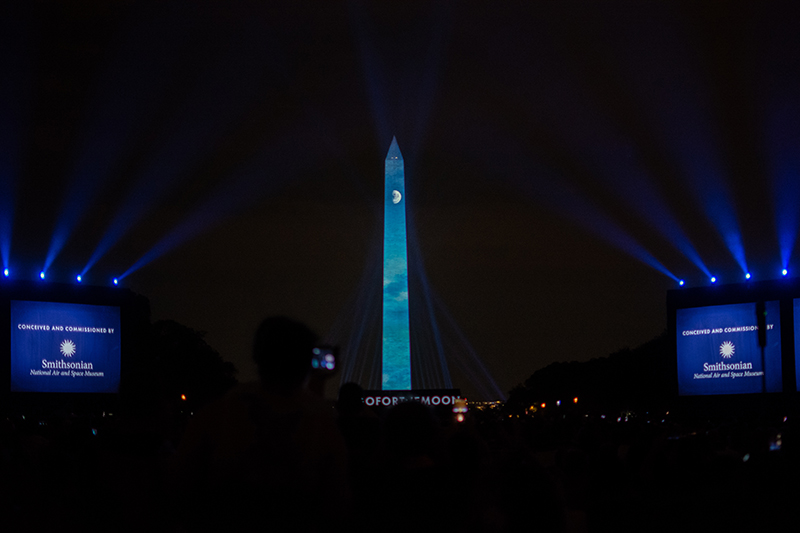
A Monumental Challenge
About a month before the Apollo celebration took place, the production team learned that monument engineering staff, by design, did not have select control to shut off individual sections of the architectural lighting on the monument. Explaining why this presented a dilemma, Holt explains, “We needed the surface we were projecting on to be dark, of course. The Museum and the Department of the Interior agreed that, as a national icon, the Washington Monument should never go dark, and worked to ensure that it was lit at all times during the project. In order to accomplish the projection on the front of the monument, production needed to substitute the necessary fixtures to cover the other three sides of the gargantuan obelisk so they would remain lighted.
“By this time I had tied up most of the IP-rated fixtures on the East Coast,” says Holt, who found a solution to the dilemma by turning to Ian Bottiglieri with Image Engineering, who serves as Holt’s Syncrolite dealer in Baltimore. “They had picked up a large inventory out of Texas when that shop closed a few years back, and they were able to supply two techs and the perfect units needed for lighting the surfaces,” Holt says. “The Syncrolite MX-4’s and SXL 7kW’s did an absolutely brilliant job of lighting the monument.”
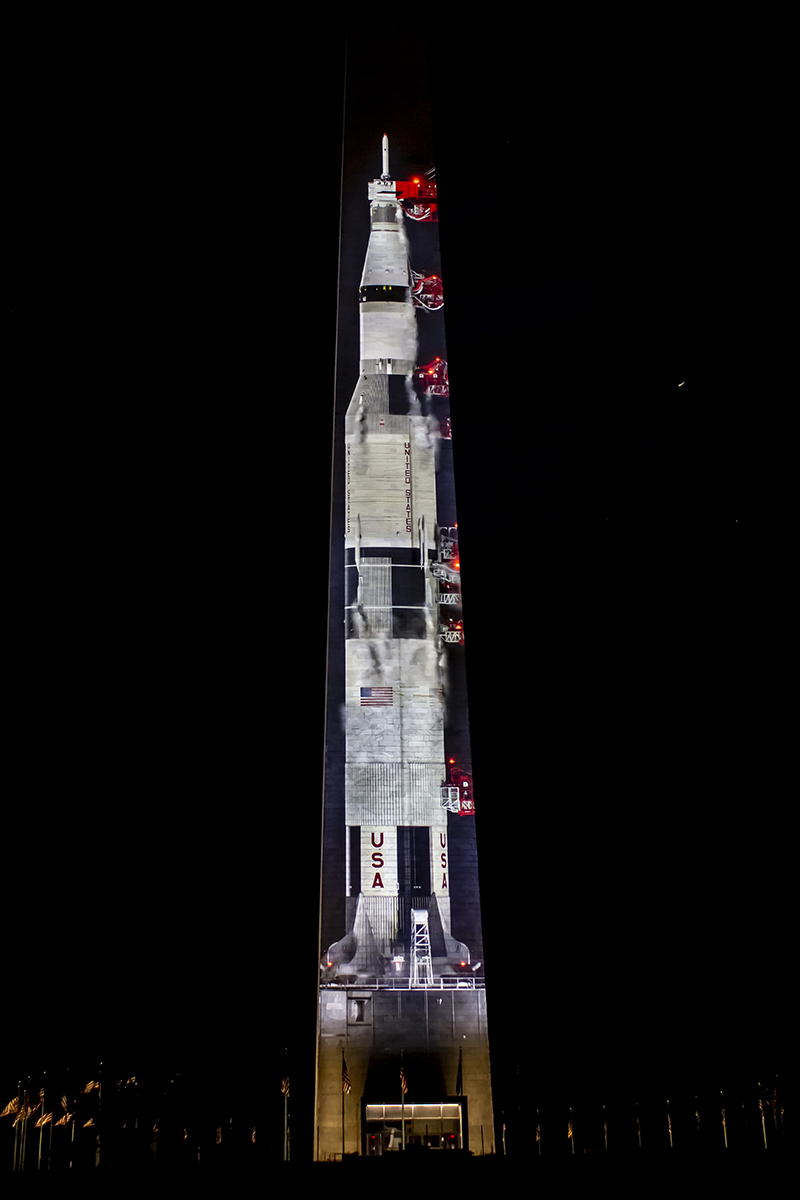
The Space Festival
Along with the imagery created for the monument and screens outside, the Air and Space Museum offered a live-streamed program, NASA’s Giant Leaps: Past and Future, chronicling the original triumph of the mission to put a man on the moon, and NASA’s future plans for manned lunar missions, which may one day support further space exploration to Mars. It featured current and veteran astronauts, engineers and administrators, and was hosted by Adam Savage of MythBusters fame. Atmosphere provided MAC Quantum washes to supplement existing lighting system. Holt designed both indoor and outdoor broadcast lighting systems.
The National Air and Space Museum’s celebration also included the three-day Apollo 50 Festival on the Mall. Holt designed and his assistant Chris Burkholder ran the performance stage. A village of individual tents with hands-on exhibits by NASA, Boeing and Raytheon showcased “all things NASA, Apollo, and Space.” NASM also contracted for a Stageline 250 mobile stage to serve as a platform for a live show. Holt was contacted to provide additional lighting for the celebrations broadcast, which took place on July 19, with the National Capitol building as the backdrop. “They needed a lot of punch to balance the background,” he says, “so I wound up putting 3,600 foot candles to balance the stage against the building.” This broadcast included uplinks to anchors in Houston and Cape Canaveral.
Another important consideration was factoring the need for multiple stage settings and different camera angles, which changed often. Holt noted that the setup included “a boatload of automated gear for ease of focus adjustments,” and the fact that they were all LED was helpful as well, “because it stayed 95 degrees outside, and I really did not want to melt the host’s faces off!” The stage also served as the performance space for The LEGO Group, and PBS’s “Ready Jet Go!”
As noted, the static image of the Saturn V rocket appeared on the monument for “teaser” events on July 16, 17 and 18, with the main 17-minute show taking place at 9:30, 10:30 and 11:30 p.m. on July 19 and 20. (The only deviance from that schedule was on the night of July 20, when the 10:30 p.m. show was delayed, Whetstone notes, “so as to time the moment Neil Armstrong stepped on the moon in the video at precisely 50 years — to the second — from the original in 1969.”)
NASM also contracted Linder Global, a local DC company that works very closely with Metro and the National Parks teams, to manage all site-related concerns including all health and safety support, first responders, lost child responses and VIP entrances as well as all security for both the general event and the production and equipment zones. “Their involvement was a big key to being able to work unencumbered and safely while still maintaining full public access to The Mall throughout the process,” says Whetstone, and the event went smoothly, even amid the DC heat wave in late July.

Crew
- NASM Executive Producers: Katie Moyer, Nick Partridge
- 59 Productions Director: Richard Slaney
- DWP Live Crew: Danny Whetstone, project manager; Eric Durett, production manager; Josh James, video crew chief/utility; Edward Lunsford, systems IT lead; Justin Carlson, lead projectionist; Chad Yeary, systems engineer; Liz Pinkston, production assistant
- Atmosphere Crew: Jim Jenets, crew chief & system/network engineer; Jason Cowperthwaite, assistant crew chief; Eric Spause, Lucas English, Syncrolite techs; Chris Burkholder, programmer for broadcast stage; Eric Nance, systems tech for broadcast stage; Alex Monsell, Rex Hsu, Abigail Hirsch, Bryan Miller, lighting crew leads
- Eighth Day Sound Crew: Beau Alexander, project manager; Richie Gibson, systems engineer; Justin Stiepleman, stage technician; Sean Tingle, Mike Vultaggio, sound system deployment
- United Staging & Rigging Crew: Mauricio Moreno, lead staging supervisor; Leanoard Williams, Matt Kern, staging supervisors; Andrew Wilkinson, project manager
- Elite Multimedia Crew: Jon Chavez, project manager; Jason Turner, Ben Anholzer, LED technicians
- Aggreko Event Manager: Daryl Benz, event manager
- Pete’s Big TV’s: Peter Daniels, president/CEO
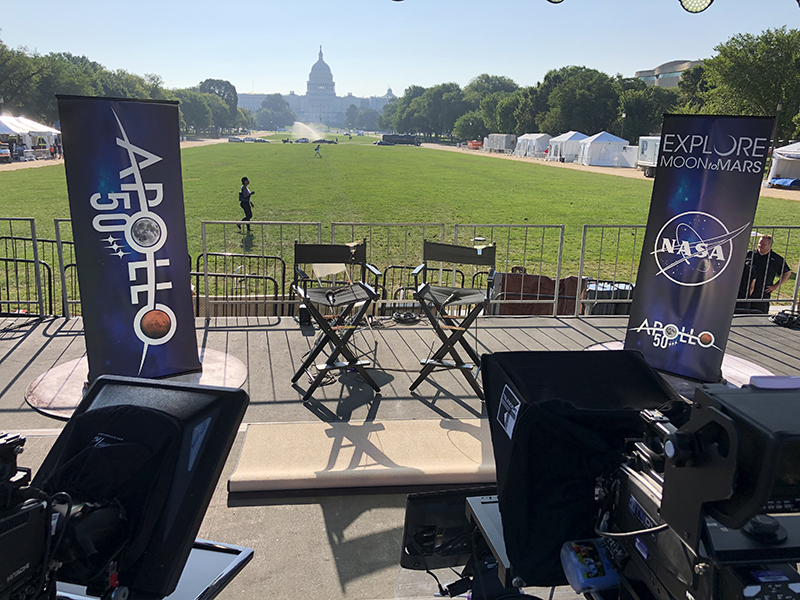
Gear
Video/Projection:
- 24 Barco UDX-4K32 projectors
- 8 Barco HDF-W30 projectors
- 2 DWP Live content servers
- 2 disguise 4x4Pro media servers with SDI VFC’s
- 2 disguise Solo media servers
- 5 Panasonic HE-130 PTZ cameras
- 5 BMD 3G-SDI routers
- 2 Decimator 3G-SDI (multi-view)
- 5 Panasonic 55” monitors (multi-view)
- 2 DigiLed DLP 5.9mm screens (18’ x 24’)
- 120 FLEX Tour 4.8mm LED tiles (for countdown clock)
Lighting for Monument:
- 24 Claypaky Mythos 2 (in Igloo Domes)
- 12 Syncrolite MX4’s
- 4 Syncrolite SXL’s
- 23 Elation Proteus Beams
Lighting for Audience Area:
- 18 Chauvet Maverick Storm One Wash fixtures
- 40 Color Kinetics ColorBlast12 fixtures
Lighting Network and Control:
- 12 Dimmer Beaches in two control locations: the 15th Street NW compound and 10th St. NW FOH area
Switching/Routing:
- 4 UniFi Switch 8 60w (US-8-60W)
- 8 UniFi Switch 8 150w (US-8-150W)
- 2 UniFi Switch 16 150w (US-16-150W)
- 2 UniFi Switch 24 (US-24)
- 2 UniFi Switch 16 XG (US-16-XG), (12xSFP+, 4x10G Copper)
- 1 UniFi Security Gateway PRO (USG-PRO-4)
- 1 UniFi Cloud Key (UC-CK)
DMX Gateways:
- 8 Pathway Pathport Octo
- 4 Pathway Pathport Quattro
WDMX:
- 1 WDMX G4 transmitter for well fits
Network Cable/Physical Infrastructure:
- 28,000’ of fiber spread across 22 links
- 1,200’ of Cat6 spread across four links
Audio Setup:
- 44 KSL8 speaker cabinets
- 36 J-Sub speaker cabinets
- 24 J8 speaker cabinets
- 40 D80 amplifiers
- 12 Lake LM44 processors
